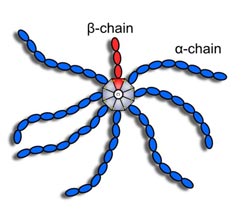Protein shaped like a spider

Schematic of the "spider protein" C4BP.<br>© HZI / Schmelz <br>
The immune protein C4BP is potentially suitable as a transporter for drugs.
The protein C4BP is similar to a spider in its spatial form with eight “arms”. The structure of the “spider body” has recently been described in detail by researchers from the Helmholtz Centre for Infection Research (HZI) in Braunschweig and the Technische Universität Darmstadt. This leads the scientists to unconventional ideas – the protein is possibly suitable as a scaffold for the transport of active pharmaceutical substances, particularly biomolecules.
The researchers are publishing their results in the current edition of the international journal Journal of Molecular Biology.
The so-called complement system is a part of the innate immune defence within the human body: more than sixty different proteins form one of the first countermeasures against invading pathogens. One of them is the C4b binding protein known as C4BP. It is involved in the immune defence against bacteria in the blood. How precisely such protein substance carries out its function or how it interacts with other molecules – this can only be predicted by scientists once they have identified the spatial structure of the molecule. Structural biologists therefore examine the substance in its purest form with x-ray machines and are able to reconstruct the spatial design in a computer. Regarding the case of the recently-described C4BP, they found out that it has eight “arms” and thus resembles a spider to a certain degree. Seven of the “arms” are identical as “alpha chains”, while the eighth, a “beta chain” is different from the others. The spider body that holds these side chains together is called the oligomerisation domain. Its structure was of special interest to researchers, since it determines the spatial alignment of the “arms”.
The newly-described structure allows two possible variants. “However, there is one of these two possibilities that is more feasible because it is much more stable”, says Thomas Hofmeyer, PhD student at the Institute for Organic Chemistry and Biochemistry of TU Darmstadt and first author for the publication. And the C4BP is quite stable, as explained by the other first author Dr. Stefan Schmelz from the Department of Molecular Structural Biology of HZI: “Even boiling is not able to break down its form.” Usually, human proteins remain stable up to about 40°C. Higher temperatures are of course not found in the body, but the stability of C4BP has a completely different purpose: “As is the case with all components of the complement system, the C4b binding protein is present in blood plasma. The proteins are exposed to enormous shear forces in the blood stream”, explains Dr. Andrea Scrima, head of the junior research group “Structural Biology of Autophagy“ at HZI. Therefore, the protein needs a high stability in order to be able to withstand these forces.
The researchers now would like to make use of the spatial structure. Their discoveries have facilitated biochemical synthesis of the molecule. In the context of replication within a test tube, the researchers can undertake alterations in a targeted way: “Instead of the seven alpha chains, we could implement other biomolecules”, claims Prof. Harald Kolmar, director of the work group Applied Biochemistry at the Institute for Organic Chemistry and Biochemistry at the Technische Universität Darmstadt. “We can use the oligomerisation domain as a framework, in order to decorate it with drug molecules.” These could be vaccines, for example. Seven with one stroke, by means of the seven-fold binding capability. Bundled in this manner, more active ingredient could make its way to its target. The dosage could be reduced but the immune system would still be considerably stimulated. “It is thereby possible in the future that bottlenecks, limiting the supply of vaccine, could be avoided and side effects reduced”, says Kolmar.
Original publication:
Thomas Hofmeyer*, Stefan Schmelz*, Matteo T. Degiacomi, Matteo Dal Peraro, Matin Daneschdar, Andrea Scrima, Joop van den Heuvel, Dirk W. Heinz, Harald Kolmar, * contributed equally
Arranged Sevenfold: Structural Insights into the C-Terminal Oligomerization Domain of Human C4b-Binding Protein
Journal of Molecular Biology, 2013, DOI: 10.1016/j.jmb.2012.12.017
The Helmholtz Centre for Infection Research:
At the Helmholtz Centre for Infection Research (HZI) in Braunschweig, scientists are studying microbial virulence factors, host-pathogen interactions and immunity. The goal is to develop strategies for the diagnosis, prevention and therapy of human infectious diseases.
http://www.helmholtz-hzi.de/en
The Technische Universität Darmstadt:
The Technische Universität (TU) Darmstadt is one of Germany’s leading technical universities. Its around 300 professors, 4,500 scientific and administrative employees and 25,000 students devote their talents and best efforts to the significant future research fields energy, mobility, communications and information technologies, housing and living.
http://www.tu-darmstadt.de
Media Contact
All latest news from the category: Life Sciences and Chemistry
Articles and reports from the Life Sciences and chemistry area deal with applied and basic research into modern biology, chemistry and human medicine.
Valuable information can be found on a range of life sciences fields including bacteriology, biochemistry, bionics, bioinformatics, biophysics, biotechnology, genetics, geobotany, human biology, marine biology, microbiology, molecular biology, cellular biology, zoology, bioinorganic chemistry, microchemistry and environmental chemistry.
Newest articles

Silicon Carbide Innovation Alliance to drive industrial-scale semiconductor work
Known for its ability to withstand extreme environments and high voltages, silicon carbide (SiC) is a semiconducting material made up of silicon and carbon atoms arranged into crystals that is…

New SPECT/CT technique shows impressive biomarker identification
…offers increased access for prostate cancer patients. A novel SPECT/CT acquisition method can accurately detect radiopharmaceutical biodistribution in a convenient manner for prostate cancer patients, opening the door for more…

How 3D printers can give robots a soft touch
Soft skin coverings and touch sensors have emerged as a promising feature for robots that are both safer and more intuitive for human interaction, but they are expensive and difficult…





















